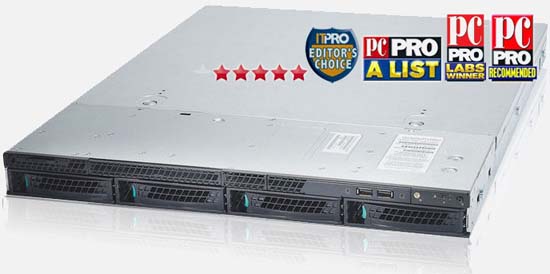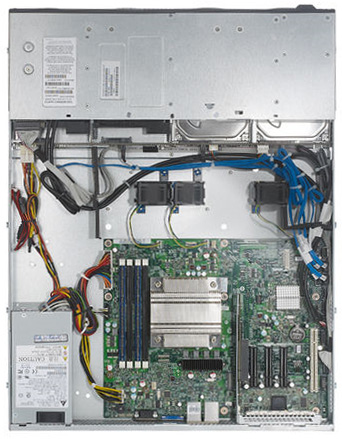Read Product Review CyberServe XE3-R130
A compact, entry-level rack server that's impressively efficient and priced just right for small businesses
Dave Mitchell 17 Jun 2011 |



Configure From $1,299.58 or Configure

A compact, entry-level rack server that's impressively efficient and priced just right for small businesses
Dave Mitchell 17 Jun 2011 |



Configure From $1,299.58 or Configure


Since the launch of the Xeon E3-1200 processor family, Intel has increased the range to eleven 32nm models ranging from 2.2GHz right up to 3.5GHz. We saw Supermicro jump in first with the Boston Value Series 570; now it's time to find out what Intel itself can produce using the chips.
Supplied to us by Broadberry Data Systems, the CyberServe XE3-R130 is an Intel Server System R1304BTL, which is a neat amalgamation of its S1200BTL motherboard and R1304 1U rack chassis. The primary focus is the entry-level market small businesses looking for their first rack server, for whom it aims to offer a low-cost but high-performance solution for web, file, print and email serving.
The price includes a 3.1GHz Xeon E3-1220: quad-core with an 8MB cache and Intel's Turbo Boost to step speed up to a maximum of 3.4GHz. Its low TDP of 80W made its mark in our power tests, with the review system drawing a mere 33W with Windows Server 2008 R2 64-bit idling along. With SiSoft Sandra putting all cores under extreme pressure this peaked at only 91W.
The compact chassis is just 22in deep and will fit neatly into most standard rack and data cabinets. It'll also be fairly unobtrusive on a desktop, as we found the three internal cooling fans nice and quiet.
This review model has four hot-swap drive bays at the front; alternatively, the lower-cost R1304BTS version comes with cold-swap bays. The four removable drive carriers are arranged across the front with a grille above to allow air to flow through the chassis. Our review system came with a pair of 500GB Seagate SATA hard disks.
The panel provides a couple of USB ports and an LED display showing power status and activity for the network ports and hard disks. This also ties in with Intel's Light Guided Diagnostics panel at the back of the motherboard, which provides troubleshooting assistance when hardware faults are detected.
The S1200BTL motherboard sports Intel's C204 chipset, the mid-point of the three Cougar Point chipset models. It provides a pair of SATA 6Gbits/sec and four SATA 3Gbits/sec ports. RAID options start with mirrors and stripes, but you can add Intel's optional hardware key to activate RAID5.

It's possible to convert all four drive bays to support 6Gbits/sec SAS drives without using the spare PCI Express slot, as the motherboard has a mezzanine connector at the front. Intel offers four snap-in card options, each with four SAS ports supporting different array combinations. The AXXRMS2AF04, for example, supports up to four 6Gbits/sec SAS drives plus mirrors, stripes and RAID5.
Along with the single PCI Express x16 expansion slot, you get a pair of Gigabit Ethernet ports. This should be enough for most small businesses if not, Boston's Supermicro-based Value Series 570 is a lot dearer but has four embedded ports.
Internally, the XE3-R130 is tidy with easy access to all the important bits. The standard ATX motherboard has plenty of empty space around it, and although the cooling fans aren't the hot-plug variety they are easy to remove and replace.
The server can be remotely managed via a web browser, as Broadberry has included Intel's miniscule RMM4 Lite module. This snaps into an equally tiny slot on the motherboard, where it shares access with the first Ethernet port. If you want a separate management port, you can specify Intel's dedicated RMM4 NIC controller, which snaps into another slot alongside the RMM4 Lite connector and extends an extra network port to the rear panel.
The RMM offers a simple web interface with easy access to all management features. It's similar to Supermicro's IMM option, and provides a page of sensor readouts with preset high and low thresholds. If breached, these thresholds are used to post entries in an event log and to issue alerts via SNMP traps and email.
Unlike the blue-chip server vendors, you don't get power controls or usage graphing tools. However, the RMM4 Lite does include KVM-over-IP remote control and virtual media services as standard, which the likes of HP and Dell charge extra for.
Bear in mind Intel's other E3 board, the S1200BTS, doesn't have these RMM slots so cannot be remotely managed. It also uses the C202 chipset, which has six SATA 3Gbits/sec ports and doesn't support SAS expansion cards.
As an entry-level rack server, the CyberServe XE3-R130 hits the spot on a number of counts. For a modest £899 exc VAT it offers good value, has a decent specification and some useful expansion capabilities, and the Xeon E3 processor will keep running costs down to a minimum. It's our new A List champion.
Author: Dave Mitchell